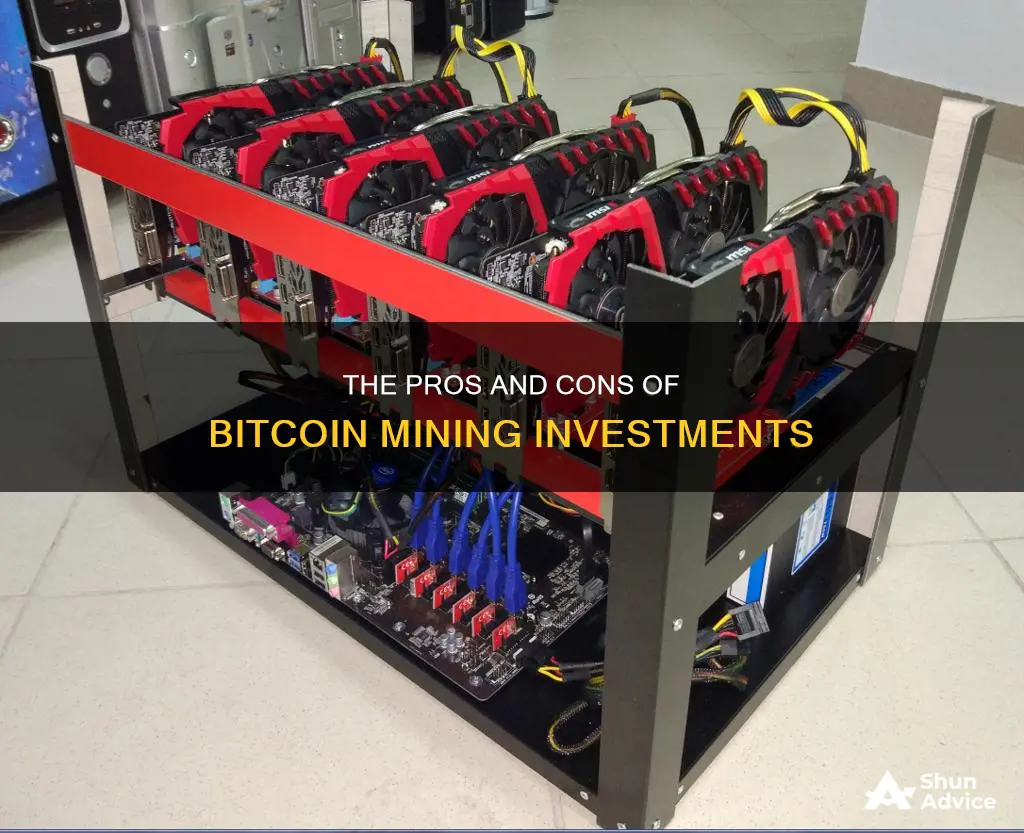
Bitcoin mining is a process that creates new Bitcoins and releases them into circulation. Bitcoin miners are responsible for confirming transactions and creating new coins. They receive Bitcoin rewards for their efforts. Bitcoin mining is still profitable for some individuals, but it requires a capable system, joining a mining pool, and the ability to pay off fixed expenses within a reasonable amount of time. The process of Bitcoin mining requires substantial hardware and software, as well as a deep understanding of the cryptocurrency market.
| Characteristics | Values |
|---|---|
| Process | Creating new bitcoins by solving complex math problems |
| Purpose | Validating transactions and keeping the network secure |
| Reward | 3.125 BTC per block |
| Reward Frequency | Every 10 minutes |
| Reward Halving | Every four years |
| Energy Consumption | 176 terawatt-hours of electricity each year |
| Energy Consumption Comparison | More than most countries |
| Hardware | Application-specific integrated circuits (ASICs) |
| Hardware Cost | Up to $10,000 |
| Profitability | Depends on equipment and electricity costs, mining difficulty, and bitcoin's market value |
| Taxation | Mined bitcoin is taxed as income; capital gains tax applies if bitcoins are sold above the price they were received at |
What You'll Learn

Bitcoin mining hardware
The hash rate of a mining machine refers to the number of hashes it can generate per second, and the higher the hash rate, the more Bitcoin you will be able to mine. Power consumption is measured in watts and represents the amount of electricity the machine will require to function. It is important to consider both of these factors when purchasing mining hardware, as the electricity costs will impact your overall profitability.
Some of the most profitable and popular ASIC Bitcoin miners on the market include:
- Bitmain Antminer S21 Hyd 335T
- Canaan Avalon Made A1266
- MicroBT Whatsminer M50S
- Bitmain Antminer S19 XP Hyd 255T
- MicroBT WhatsMiner M56S
When choosing Bitcoin mining hardware, it is important to consider your budget, the expected return on investment, the machine's efficiency, and the noise levels it produces. Additionally, ensure that you have access to cheap electricity, as the high energy consumption of these machines can significantly impact your profitability.
Strategic Steps to Invest in Bitcoin Mining Companies
You may want to see also

Bitcoin mining software
There are several bitcoin mining software options available, each with its own unique features and capabilities. Some software is designed for beginners, offering an easy-to-use platform and a simple setup process. Other software is more advanced, providing a range of customisation options and support for a wide variety of mining hardware.
- CGMiner: One of the oldest bitcoin mining software programs, CGMiner supports the mining of various cryptocurrencies, including Dogecoin and Litecoin. It offers remote management of mining rigs and works with a range of hardware, including ASICs, FPGAs, and GPUs. However, it runs on a command-line interface, which can make it challenging for beginners.
- Awesome Miner: Awesome Miner allows users to manage all their mining activity in one place, supporting multiple mining engines and pools. It offers a dashboard to track mining performance, including hash rate, device temperature, fan speeds, and earnings. Awesome Miner is accessible via a web browser and runs on Windows and Linux.
- EasyMiner: EasyMiner is a user-friendly platform that automatically starts mining cryptocurrency upon setup. It focuses on CPU and GPU mining capabilities and provides a dashboard for monitoring workflows and switching mining pools. EasyMiner also offers enhanced security, protecting mining activity and wallets.
- Kryptex Miner: Kryptex Miner is a Windows app that pays users for their computer power, automatically switching to the most profitable cryptocurrency to mine. It offers a "lite mode" for internet use and other activities, but charges fees for payments.
- ECOS: ECOS is a cloud-based mining platform that allows users to mine bitcoin without purchasing specialised equipment. Users pay upfront for a mining contract, leasing mining hardware and electricity. While profit margins may be lower than with owned equipment, ECOS provides a simple and accessible mining solution.
These software options vary in terms of compatibility, features, and ease of use, catering to different user needs and expertise levels. It is important to research and choose the software that best aligns with your specific requirements and mining setup.
Bitcoin Investment: Timing the Market Entry
You may want to see also

Bitcoin mining pools
Miners in a pool share their computing power over a network and are rewarded based on the amount of power they contribute. This is in contrast to solo mining, where the miner must find a block to receive a reward. Mining pools, therefore, make revenue for miners more predictable.
There are several types of payout schemes used by mining pools. Some common types include:
- Pay per share (PPS)
- Pay per last N shares (PPLNS)
- Pay per share plus (PPS+)
- Full pay per share (FPPS)
The best mining pool is generally one that is transparent about how it operates and uses a payout scheme the miner is happy with. Pools that are too large may be detrimental to individual miners.
Some of the most popular mining pools include:
- Foundry USA
- Binance Pool
- Ultimus Pool
- AntPool
- Foundry
- ViaBTC
- F2Pool
Smart Ways to Invest 50 Dollars in Bitcoin
You may want to see also

Bitcoin mining profitability
The profitability of bitcoin mining depends on the following factors:
- Cost of equipment: The hardware required for bitcoin mining can be expensive, with ASIC devices ranging from $1,000 to over $15,000.
- Hash rate: The number of hashes per second that a mining device can generate. A higher hash rate leads to higher earnings.
- Efficiency: The amount of energy a mining device consumes, measured in watts per terahash. A more efficient device will lead to lower electricity costs.
- Electricity costs: Bitcoin mining consumes a significant amount of electricity, so miners need to have access to cheap electricity to be profitable.
- Price of Bitcoin: The volatile nature of Bitcoin's price makes it difficult to predict earnings.
While it is possible to make profits from bitcoin mining, it is important to consider the high upfront costs of equipment, ongoing electricity costs, and the difficulty in making a profit as a solo miner. Joining a mining pool can help increase the chances of profitability by sharing resources and rewards. However, the extreme volatility of Bitcoin's price and the regulatory risks associated with cryptocurrencies are important factors to consider.
Getting Started with Bitcoin: How Much Do You Need?
You may want to see also

Bitcoin mining risks
Bitcoin mining is an expensive and risky endeavour. Here are some of the risks you should be aware of:
Financial Risk
Bitcoin mining requires a substantial upfront financial investment in hardware and software. The equipment is expensive, ranging from a few thousand dollars to tens of thousands of dollars, and there is no guarantee of a return on this investment. The mining process is complex and competitive, and the probability of receiving any reward is slim, especially when mining alone.
Price Volatility
The price of bitcoin is extremely volatile and unpredictable. This makes it difficult for miners to know if their reward will outweigh the high costs of mining. A drop in the price of bitcoin can significantly impact earnings.
Regulatory Risk
The bitcoin market currently operates with little to no regulation. The government doesn't have a clear stance on cryptocurrency, and it is not taxed. However, a lack of taxation could lead to problems if bitcoin is seen as competition for government currency. There is also a risk that governments could outlaw bitcoin mining, as seen in China in 2021.
Technology Reliance and Cyber Threats
Bitcoin is entirely reliant on technology, and without it, cryptocurrency is worthless. Bitcoin owners are vulnerable to cyber threats and online fraud. Hacking is a serious risk, as there is often no way to retrieve lost or stolen bitcoins. Additionally, there is a fair amount of fraud in the bitcoin market, with fake exchanges duping unsuspecting investors out of their bitcoins.
Environmental Impact
Bitcoin mining has a significant environmental impact due to the vast amounts of energy required by the network. This has drawn criticism from environmental groups and limits the profitability of miners. The energy consumption also contributes to a large amount of electronic waste as mining firms must continually upgrade their equipment to remain competitive.
Block Withholding
A mining pool can use its computational power to mine a block and hide it from honest miners, allowing a select few to reap the benefits while others are left with nothing.
Spot Bitcoin ETF: A Beginner's Guide to Investing
You may want to see also
Frequently asked questions
Bitcoin mining is the process of creating new bitcoins by solving extremely complicated math problems that verify transactions in the currency. When a bitcoin is successfully mined, the miner receives a predetermined amount of bitcoin.
You will need a wallet, mining software, and computer equipment. The most cost-prohibitive aspect of Bitcoin mining involves the hardware. You’ll need a powerful computer that uses an enormous amount of electricity in order to successfully mine Bitcoin.
It depends. Even if Bitcoin miners are successful, it’s not clear that their efforts will end up being profitable due to the high upfront costs of equipment and the ongoing electricity costs.
It depends on several factors, including the cost of electricity to power the mining machines, the speed of your miner(s), its cost, and mining pool payouts.
Bitcoin mining is generally allowed in the U.S., but some other countries have outlawed it — China is one major example. Even if you're in the U.S., it's worthwhile to check your local regulations.







